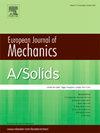A chemomechanical coupling model for diffusion and stress analysis in polymer-based anti-corrosion coatings
IF 4.4
2区 工程技术
Q1 MECHANICS
引用次数: 0
Abstract
The phenomenon of chemomechanical coupling significantly impacts the service performance and lifespan of organic anti-corrosion coatings. Due to differences in matrix materials, the chemomechanical coupling mechanism in organic anti-corrosion coatings is different from that in metal-based materials. How to accurately characterize the chemomechanical coupling behavior in organic anti-corrosion coatings has become an important issue. In this work, a new theoretical model of strong chemomechanical coupling is established for polymer-based anti-corrosion coatings, in which the stress-dependent chemical potential gradient is employed as the fundamental driving force for diffusion and the influence of stress on the diffusion coefficient is considered based on the concept of free volume theory. The model is further utilized to examine the distribution and evolution of the chemomechanical coupling field within a polymer-based anti-corrosion coating system under external loading. Compared with the analysis results of existing weak coupling models, it is found that strong chemomechanical coupling significantly affects the diffusion rate of substances, which in turn affects the concentration field and stress field within the coating. In addition, this model can also explain the experimental result that hydrostatic pressure diminishes the diffusion coefficient. The proposed strong coupling model should be significant in precisely analyzing the diffusion process and mechanical properties of materials or structures in chemomechanical coupling environments.
求助全文
约1分钟内获得全文
求助全文
来源期刊
CiteScore
7.00
自引率
7.30%
发文量
275
审稿时长
48 days
期刊介绍:
The European Journal of Mechanics endash; A/Solids continues to publish articles in English in all areas of Solid Mechanics from the physical and mathematical basis to materials engineering, technological applications and methods of modern computational mechanics, both pure and applied research.

 求助内容:
求助内容: 应助结果提醒方式:
应助结果提醒方式:


